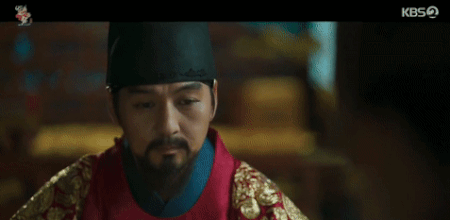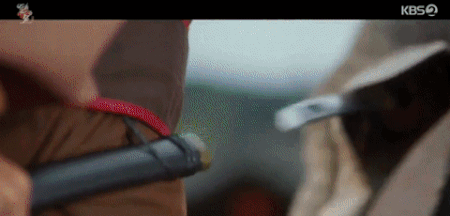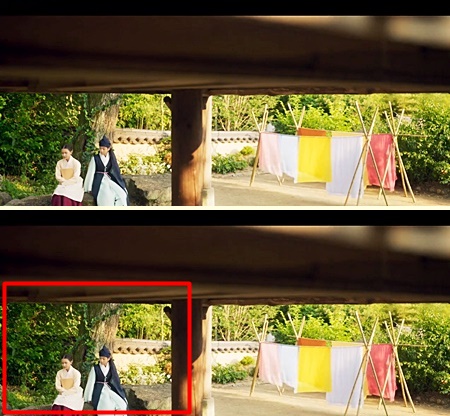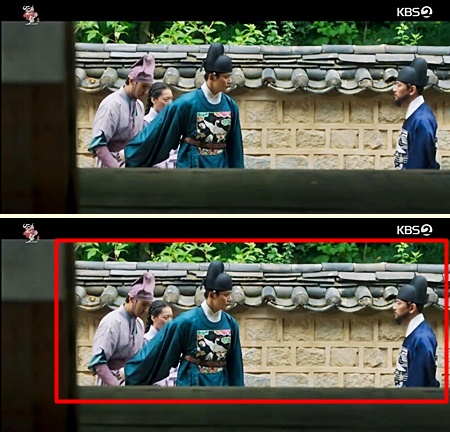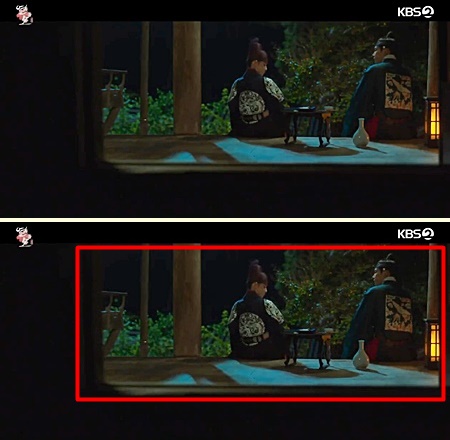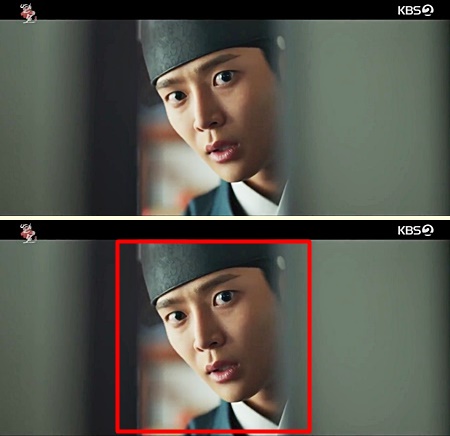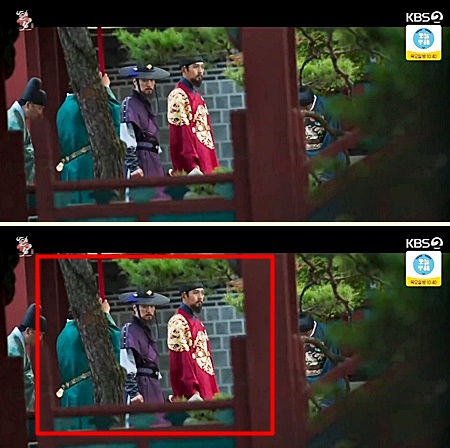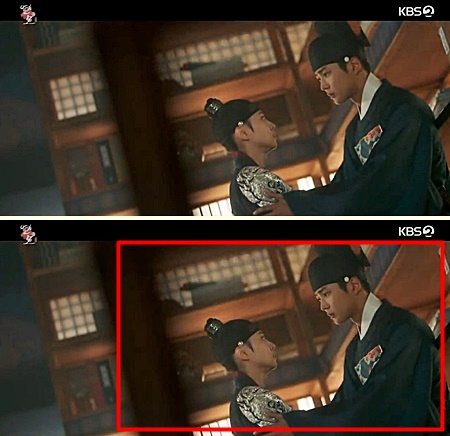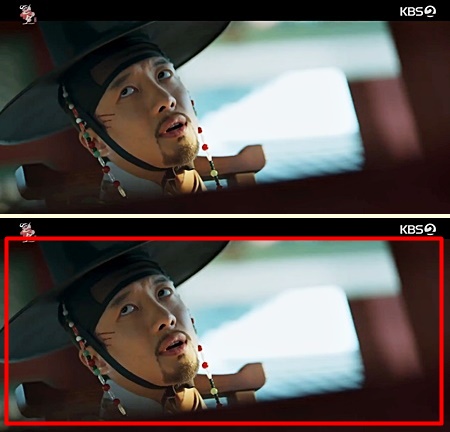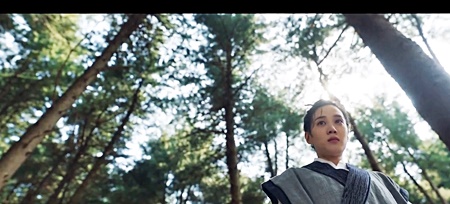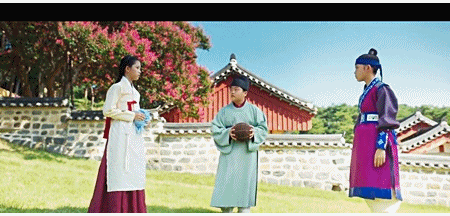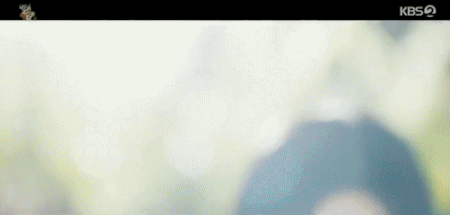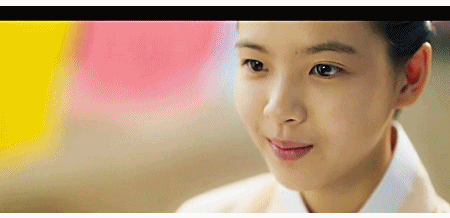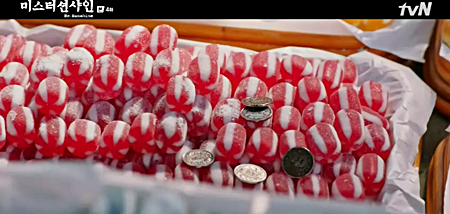(Click the picture above to view a bigger copy in another tab.)
|
|
From Wikipedia: “The King’s Affection” (“Yeonmo” lit. “Affection”) is a South Korean television series starring Park Eun-bin, Rowoon, Nam Yoon-su, Choi Byung-chan, Bae Yoon-kyung, and Jung Chae-yeon. It aired on KBS2 from October 11 to December 14, 2021 for 20 episodes. It is available for streaming on Netflix in selected regions.
Genre: historical, romance, fiction, comedy.
The series is based on Lee So-young’s manhwa “Yeonmo,” which sets the birth of the protagonist in 1461.
The story is set during the Joseon Dynasty, at a time when twins were considered an ominous sign. As a result, when the Crown Princess Consort gives birth to twins, an order is sent to kill the daughter. To save her, she is secretly sent out of the palace.
A few years later, the twin daughter Dami returns to the palace to work as a maid. When the male twin, Lee Hwi, loses his life through a case of mistaken identity, their mother, having recognised her daughter as court maid Dami, persuades her to take Lee Hwi’s place. Although she distances herself from everybody, Yi Hwi (Dami) starts developing feelings for Jung Ji-woon, her original first love and later teacher who comes from a noble family.
How I wrote these episode summaries with no spoilers
1. I assumed that you will be reading these summaries and watching the videos chronologically.
2. I narrated some of the main actions in each episode without revealing the plot’s twists and turns.
3. At the beginning of each summary starting with Episode 2, I placed in a table a recap of the major twists and turns of the previous episode. But because you have already watched the video of the previous episode, they aren’t spoilers anymore.
4. I followed this structure all throughout, except for Ep. 20 (Finale) where I included spoilers. Reason — most people want to know if the drama has a good/happy ending or a sad ending before they invest the time in watching it.
Episode 1
The King explodes in anger after finding out from Crown Prince Hyejong and Left State Councilor Han Ki-jae (“Lord Sangheon”) that the Crown Princess has given birth to twins — the eldest a boy, the youngest a girl. He orders Crown Prince Hyejong to kill the girl; meanwhile, Lord Sangheon also orders Inspector Jung Seok-jo of the Royal Investigative Bureau and his men to kill all the people in the Royal Pharmacy who were present during the twins’ birth.
The Crown Princess saves her baby girl; she orders her loyal bodyguard to take the baby girl as far away as possible from the palace.
Years later, the boy is now the friendly and studious Prince Lee Hwi who loves playing “cuju” (Joseon football). One day, along with his faithful young eunuch Bok-dong, he comes face-to-face with Dam-i, a young court maid who looks exactly just like him.
The Crown Princess learns from Prince Lee Hwi about a young court maid who looks exactly like him. She orders her attendant, Court Lady Kim, to bring the court maid to her.
Prince Lee Hwi exchanges places with Dam-i in order to visit his beloved Royal Tutor, who has been imprisoned because of accusations made by his grandfather Lord Sangheon.
Jung Ji-un, the young son of Inspector Jung, meets Dam-i while she’s doing laundry in a secluded garden in the palace. When Dam-i’s precious book falls into the pond, she wants to retrieve the book, but Ji-un stops her, saying that he’ll just buy for her a new copy.
As Court Lady Kim and Dam-i are on their way to the Crown Princess’s quarters, Inspector Jung sees Dam-i.
Episode 2
| Ep. 1 recap:
The Crown Princess recognizes that Dam-i is her daughter through the scar on her neck (caused by the acupuncture needle). While disguised as Prince Lee Hwi, Dam-i comes face-to-face with Crown Prince Hyejong. Dam-i saves Ji-un from drowning in the pond; later on, they spend time together during the festival. When the Royal Tutor is sentenced to be beheaded, Prince Lee Hwi again disguises himself as Dam-i so that he can see his beloved tutor for the last time. He goes along with the entourage of court ladies and court maids as they leave the palace to attend an event. At the market, he runs away from the entourage, but Inspector Jung chases him and shoots him down with an arrow. |
After visiting and paying his respects to Prince Lee Hwi (Dam-i) on his birthday, Ji-un sees his father Inspector Jung leading Dam-i’s court maid friend I-wol to a secluded spot in the palace.
Ten years later ... Dam-i (aka Prince Lee Hwi) is a cold and bitter prince, who’s known for the nicknames “Ice Prince” and “Five Step Prince.” She has taken to heart the warning from her mother, the Crown Princess, that, in order to survive in the palace, the people around her must fear her; her mother also told her to use her hate and resentment as reasons to stay alive.
Court Lady Kim and Eunuch Bok-dong still serve Dam-i faithfully.
Dam-i joins the royal hunt with the other princes of the royal family. Among the princes is her uncle Prince Changun, who, in front of Prince Jehyeon and Prince Wonsan, badmouths her for being the Crown Prince simply because of her grandfather Lord Sangheon’s support and for being a “delicate flower.”
Episode 3
| Ep. 2 recap:
Despite Ji-un’s pleas, his father Inspector Jung kills Dam-i’s court maid friend. Unknown to them, Dam-i sees everything. Dam-i’s mother, the Crown Princess, dies. Ji-un returns from Ming after saving the life of a high ranking Ming official; he sets up the Samgaebang clinic which caters to the beauty needs of gisaengs and women from noble families. But he gets into trouble when his treatment causes pustules to appear on the face of the Minister of Personel’s daughter. In order to save his female assistant from harm, he promises the minister’s daughter that he will provide her the herbs needed to cure the pustules on her face. During the royal hunt, Prince Changun shoots an arrow at Prince Lee Hwi (Dam-i), hitting her “sangtu” (topknot). After falling off from her horse, Dam-i hides in a secluded spot and takes off her prince’s robes. Unknown to her, Ji-un sees her. |
When the different factions of ministers accuse each other of instigating the assassination attempt, King Hyejong orders an investigation; on the other hand, the Queen Mother scolds the Queen (Prince Jehyeon’s mother) for being present at the royal hunt.
Court Lady Kim asks Dam-i why she didn’t kill the man she met in the woods who could have been part of the assassination attempt against her. Dam-i says that she didn’t want to complicate matters and that the man is a herb gatherer who won’t be setting foot inside the palace.
While practicing archery late at night, however, Dam-i sees Ji-un alone on the palace grounds; she takes her bow and arrow and runs after him.
Ji-un avoids the guards at the exit and walks to the hidden gate that leads to the secluded garden where he and Dam-i met ten years ago. As Dam-i aims her bow and arrow at him, she remembers how her mother, the Crown Princess, ordered her to kill a court maid who found out the truth of her being female; her mother told her to kill anyone who will find out about her true identity. When she hesitated, her mother stabbed the young court maid.
Episode 4
| Ep. 3 recap:
At the river bank, Dam-i and Ji-un don’t recognize each other as the young court maid and young master who met and spent time together ten years ago. When they get cornered on a cliff by Prince Wonsan and the royal guards, Dam-i pushes Ji-un into the river below, but Ji-un pulls her along with him. Just like ten years ago, Dam-i rescues Ji-un from drowning. Prince Ja-eun (Lee Hyun) and Commander Yoon rescue Crown Prince Lee Hwi (Dam-i) from the assassin. Together with Eunuch Bok-dong, Dam-i investigates if Ji-un (the herbalist-physician) is the boy she met ten years ago. Her investigation leads her to a gisaeng house where she sees and hears her uncle Prince Changun telling the Royal Tutor that he saw Prince Lee Hwi as a woman. Dam-i intervenes when Prince Changun creates trouble in the gisaeng house by beating up his drinking buddy. She warns him that he could be beheaded if it’s found out that he’s connected to the assassination attempt during the royal hunt. Dam-i confirms that the physician from Samgaebang clinic whom she met in the woods is none other than the young master whom she met ten years ago. Because the Ming delegation that will arrive soon includes the high official who Ji-un saved, Lord Sangheon orders Inspector Jung that Ji-un must be at Crown Prince Lee Hwi’s side. The next day, Inspector Jung’s men ransack the Samgaebang clinic and arrest Ji-un and his assistants. To Dam-i’s surprise, her new Royal Tutor is none other than Ji-un himself. |
Crown Prince Lee Hwi (Dam-i) protests with King Hyejong Ji-un’s appointment as Royal Tutor, saying that Ji-un deceives noblewomen and noblemen in his Samgaebang clinic and sneaks into the palace to see the court maids; she asks that Chief Gu (Ji-un’s friend) and the court maids be questioned.
Royal Scholar Yang, who’s in charge of the Royal Tutors, warns Ji-un of the various means that Crown Prince Lee Hwi will resort to in order to get him to resign.
Crown Prince Lee Hwi (Dam-i) refuses to attend Ji-un’s lecture; at the archery range, she accuses Ji-un of being an opportunist just like his father Inspector Jung.
Ji-un challenges Crown Prince Lee Hwi (Dam-i) that if she passes the exams to be given by all the Royal Tutors in front of King Hyejong and the court ministers, he will resign. When Crown Prince Lee Hwi (Dam-i) refuses to accept his challenge unless he puts his life on stake, Ji-un stands in front of the target.
When word spreads in the palace that Crown Prince Lee Hwi (Dam-i) is threatening to shoot Ji-un, Prince Ja-eun, Lord Sangheon, and some of the ministers rush to the archery range.
Conflict arises between King Hyejong and the Queen Mother when she appoints a bodyguard for Crown Prince Lee Hwi. When King Hyejong objects, she says that Lee Hwi is the Crown Prince, not Prince Jehyeon (the son of the current Queen).
Episode 5
| Ep. 4 recap:
Ji-un reveals to his friend Prince Ja-eun that he agreed to be Royal Tutor to save his assistants at the Samgaebang clinic. Later on, he overhears Lord Sangheon scolding Crown Prince Lee Hwi (Dam-i) after what happened at the archery range and saying that he can’t avoid becoming dirty into the palace. Kim Ga-on, the young, handsome warrior that the Queen Mother appointed to be Crown Prince Lee Hwi’s bodyguard, has ornaments with symbols attached to his sword; the ornaments are similar to the ornaments on the swords of the assassin during the royal hunt and the man who killed a government official. Ji-un gives some lotus seeds to Crown Prince Lee Hwi (Dam-i) as the topic for the exam and as an assignment. While thinking over what the lotus seeds mean, she comes upon the paper containing the name “Yeon-seon” that Ji-un gave to her ten years ago. During the exams, Ji-un fails Crown Prince Lee Hwi (Dam-i); the correct answer that he gives is a stinging rebuke to his father Inspector Jung and to Lord Sangheon. On the palace bridge that night, Crown Prince Lee Hwi (Dam-i) warns Ji-un to be careful with his words because the palace is a dangerous place. Ji-un replies that what he fears is that he’ll become so used to the mud that he’ll end up just like his father Inspector Jung and Lord Sangheon. After they run away from bodyguard Kim Ga-on and Eunuch Bok-dong, Prince Ja-eun gives Crown Prince Lee Hwi (Dam-i) a jade ring with a flower ornament. When his clothes get soaked with water, he leaves to buy a new hat for Crown Prince Lee Hwi (Dam-i). Ji-un sees Crown Prince Lee Hwi (Dam-i) standing on the road side with a crooked hat. He walks up to her and puts his hat on her. |
On a high point overlooking the palace, Ji-un advises Crown Prince Lee Hwi (Dam-i) to learn how to trust people. But remembering what her mother ingrained into her, Crown Prince Lee Hwi (Dam-i) replies that “human emotions are the hardest to trust; deceiving others and killing others to protect one’s self is human nature.”
While King Hyejong is looking at the flurry of cleaning up by the staff of court offices that Crown Prince Lee Hwi has just visited, his bodyguard Commander Yoon notices a man acting suspiciously. Leaving the king’s entourage, he chases the man through the palace grounds. He fails to catch up with the man, but as Crown Prince Lee Hwi (Dam-i), her attendants, and Ji-un pass him by, he becomes suspicious of Kim Ga-on, the Crown Prince’s bodyguard.
Inspector Jung visits his classmate Commander Yoon as he investigates another death among the witnesses who testified against the Royal Tutor ten years ago.
After finding out that Crown Prince Lee Hwi (Dam-i) has been meeting a man outside of the palace, Prince Changun lays out a trap for him.
Episode 6
| Ep. 5 recap:
Flashback ... The young Prince Ja-eun finds out that Dam-i is masquerading as Prince Lee Hwi. While Crown Prince Lee Hwi (Dam-i) is about to take her bath, her bodyguard barges into the room and exposes the woman sent by Prince Changun. The Queen Mother orders Prince Changun to seek Crown Prince Lee Hwi’s forgiveness. While Prince Changun is in Crown Prince Lee Hwi’s quarters and subtly warning him to forget what happened during the royal hunt, Lord Sangheon arrives and slaps him. Crown Prince Lee Hwi (Dam-i) seeks to deescalate the tension by telling Lord Sangheon that he will request King Hyejong to place Prince Changun under arrest. But Lord Sangheon warns him not to be soft but to mercilessly kill his enemies, whoever they may be. In a secluded spot in the palace, Prince Ja-eun threatens Prince Changun with his sword, warning him to never harass Crown Prince Lee Hwi ever again. Ji-un embraces and spins Crown Prince Lee Hwi (Dam-i) away from being struck by a falling vase. |
After his daughter Shin So-eun pressured him to help her visit the jail where she thought Ji-un was imprisoned, the Minister of Personnel files a petition to have Ji-un dismissed as a Royal Tutor.
During a meeting of the royal court, King Hyejong demands that Lord Sangheon explain why he hid Ji-un’s identity as the physician of Samgaebang clinic. When Lord Sangheon tries to justify why he recommended Ji-un, the Minister of Personnel says that Samgaebang clinic was closed down because it corrupted public morals.
The Queen sees the conflict between the Minister of Personnel and Lord Sangheon as a perfect opportunity for her son Prince Jehyeon.
When Dam-i shows some concern about what’s happening to Ji-un, Court Lady Kim reminds her that Ji-un’s father, Inspector Jung, killed the real Crown Prince Lee Hwi.
Episode 7
| Ep. 6 recap:
Crown Prince Lee Hwi (Dam-i) denies knowing the young court maid Dam-i who Ji-un met ten years ago. Later, she gives him a document stating that Dam-i left the palace because of illness. When she asks what Dam-i meant to him, he says that she was his first love. Prince Ja-eun reveals to Crown Prince Lee Hwi (Dam-i) that Ji-un opened Samgaebang clinic to help the poor children in the capital and that he was forced to become a Royal Tutor to save his assistants. At a pond in the palace where the attendants are floating paper lanterns, Dam-i remembers that she told Ji-un her wish that someone would someday help the poor children in the capital. Inspector Jung and his men attack the jail and snatch Ji-un’s assistants. On their way out, Ji-un confronts them; he threatens to kill himself if his assistants are not released. In the woods, Inspector Jung forces Ji-un’s assistant to write a letter confessing that he’s the real physician of Samgaebang clinic. As his men are about to hang the assistant, Crown Prince Lee Hwi (Dam-i), her bodyguard Kim Ga-on, and the royal guards arrive. Despite Lord Sangheon’s warning not to be arrogant and to merely follow whatever he says, Crown Prince Lee Hwi (Dam-i) joins the royal court just as King Hyejong is announcing his punishment for Ji-un and his assistants. |
The Queen Mother suggests to Lord Sangheon that Crown Prince Lee Hwi (Dam-i) become part of the welcome activities for the Ming delegation. But when she warns Lord Sangheon not to overstep his authority by not supporting King Hyejong, Lord Sangheon reminds her that he sacrificed so that the former king could sit on the throne. After leaving the Queen Mother’s quarters, his mood sours even more upon seeing King Hyejong with the Queen and Prince Jehyeon.
While at the market with Prince Ja-eun looking for materials to be used in greeting the Ming delegation, Crown Prince Lee Hwi (Dam-i) sees Ji-un and Shin So-eun (the daughter of the Minister of Personnel) carrying loads of flowers.
At the quarters of the Ming delegation, Crown Prince Lee Hwi (Dam-i) and Prince Ja-eun are surprised to see Ji-un together with his father Inspector Jung and Lord Sangheon.
Episode 8
| Ep. 7 recap:
Ji-un meets the Ming Vice Minister of Rites, the man he saved from choking to death while he was in Ming. The Chief Eunuch, who heads the Ming delegation, makes a secret deal with Lord Sangheon, who wants a place where he can raise and train his private army. At the welcome banquet, he makes a drunken disturbance, but Ji-un steps in to calm him down. When he was a young boy, the Chief Eunuch was sent to Ming as part of the Joseon tribute; along the way, a young girl gives him her “eunjangdo” (small silver knife) which he has kept with him all through these years. The Chief Eunuch dishonors Court Lady Kim by cutting off her hair. In retaliation, Crown Prince Lee Hwi (Dam-i) beats him up. |
Prince Ja-eun meets and subtly threatens the Chief Eunuch to behave for the rest of his mission in Joseon or else, he will reveal how he (the Chief Eunuch) accepts bribes and steals from the Ming emperor. Later, he asks Ji-un to follow the Chief Eunuch who’s meeting someone in secret.
Crown Prince Lee Hwi (Dam-i) finds out from King Hyejong that the Chief Eunuch has demanded that the Joseon tribute be doubled.
Ji-un is surrounded and attacked by the men guarding the Chief Eunuch. Crown Prince Lee Hwi (Dam-i) joins in the fight, but he’s recognized by one of the men when his mask falls off.
With a portrait based on Prince Ja-eun’s description of the man who the Chief Eunuch met secretly, Crown Prince Lee Hwi (Dam-i) and Ji-un find out that the man is the father of a Joseon girl who is an imperial concubine in Ming.
Episode 9
| Ep. 8 recap:
Flashback ... The young Kim Ga-on sees Crown Prince Lee Hwi’s Royal Tutor being beheaded. Crown Prince Lee Hwi (Dam-i) gets the secret ledger of the man who has been blackmailing the Chief Eunuch; he also finds out about the long-standing romantic relationship between the Chief Eunuch and the Joseon girl who’s now an imperial concubine. The Chief Eunuch withdraws the demand for doubling the tribute after Crown Prince Lee Hwi (Dam-i) promises to keep secret his relationship with the imperial concubine and apologizes for Joseon’s failure to help those who were sold off to Ming. Late at night, Crown Prince Lee Hwi (Dam-i) meets Ji-un in the secluded garden, which is once again blooming with flowers. Having had a lot to drink, Ji-un leans in to kiss her. |
Ji-un becomes embarrassed and confused about why he kissed Crown Prince Lee Hwi (Dam-i). He begins to see and imagine Crown Prince Lee Hwi (Dam-i) everywhere and everytime.
King Hyejong secretly meets Lord Changcheon (the Queen’s father) and orders him to build a private army to counter the private army that Lord Sangheon is raising as part of his deal with Ming’s Head Eunuch.
The Queen Mother sees Shin So-eun and No Ha-kyung (daughter of the Minister of War) in the palace courtyard. Later, in a meeting with King Hyejong, Lord Sangheon, and Crown Prince Lee Hwi (Dam-i), she says that it’s time for Crown Prince Lee Hwi (Dam-i) to get married. When King Hyejong that Crown Prince Lee Hwi (Dam-i) isn’t ready yet, Lord Sangheon accuses him of plotting to make Prince Jehyeon his successor.
On her way home, Shin So-eun and her servant meet Prince Changun, who has just finished the period for his house arrest.
When Prince Ja-eun asks whether he ever had romantic feelings for anyone, Crown Prince Lee Hwi (Dam-i) recounts how she fell in love with someone he saved from drowning in a palace pond.
Episode 10
| Ep. 9 recap:
While wandering around the palace, No Ha-kyung comes upon the door that leads to the secret garden. She stumbles, but Crown Prince Lee Hwi (Dam-i) catches and steadies her. On her way home with Shin So-eun, she says that her new dream is to become the Crown Princess. Ji-un and later Prince Wonsan stop Prince Changun from harassing Shin So-eun and her servant. Ji-un meets Crown Prince Lee Hwi (Dam-i) early in the morning and asks him for a hug. While they’re fishing, Ji-un mentions to Prince Ja-eun how the young court maid Dam-i saved him from drowning in a palace pond. After remembering what Crown Prince Lee Hwi (Dam-i) told him, Prince Ja-eun rushes off. Flashback ... The night when Ji-un got drunk, Crown Prince (Dam-i) kissed him back. |
Commander Yoon finds out that the soldier tagged as the assassin during the royal hunt could not have used a bow and arrow. In the palace, he tails Kim Ga-on but loses sight of him. When he hears sounds of fighting and comes upon a group of fallen soldiers, he’s stunned to learn that Kim Ga-on is on his way to King Hyejong’s quarters.
After King Hyejong finally approves the wedding for Crown Prince Lee Hwi, Lord Hyeon recommends to the Queen Mother a specific candidate for Crown Princess.
Episode 11
| Ep. 10 recap:
Crown Prince Lee Hwi (Dam-i) arranges a promotion for Ji-un so that they wouldn’t have to meet each other again. Commander Yoon warns King Hyejong that Kim Ga-on is a dangerous man. Lord Sangheon leaks the questions for the first round of the selection process to Ha-kyung, who’s father (the Minister of War) is his political ally. But it’s So-eun who gains the Queen Mother’s favor. King Hyejong expresses his preference for So-eun because of her father, the Minister of Personnel. Crown Prince Lee Hwi (Dam-i) thus visits So-eun, who continues to be reluctant about becoming the Crown Princess. Ji-un refuses to accept the promotion; instead, he gives Crown Prince Lee Hwi (Dam-i) his letter of resignation. |
With Lord Sangheon now backing him up, Prince Changun takes his vengeance on So-eun’s servant.
After the deaths of three government officials who testified against the Royal Tutor ten years ago, Inspector Jung warns Lord Sangheon that he could be the next target.
Conflict over Prince Changun arises with the Queen Mother and Lord Sangheon taking his side against Crown Prince Lee Hwi (Dam-i). Later on, Prince Wonsan asks Lord Changcheon, the Queen’s father, to rally the Confucian scholars against Crown Prince Lee Hwi (Dam-i).
Episode 12
| Ep. 11 recap:
Because of the rumor that So-eun is romantically involved with Ji-un even though she’s a candidate for Crown Princess, the Queen Mother tells King Hyejong to remove her from the list of candidates. Lord Sangheon, meanwhile, pressures King Hyejong to demote the Minister of Personnel. Prince Changun kills So-eun’s servant. But after finding the short sword he used to kill the servant, Crown Prince Lee Hwi (Dam-i) forces him to seek forgiveness by kneeling in front of the servant’s grave. Kim Ga-on fails to kill Lord Sangheon, but he manages to escape from Inspector Jung because of Commander Yoon. Prince Wonsan kills Prince Changun and then gives Lord Changcheon Prince Changun’s last will. Later on, he tells Prince Ja-eun that their father should have been the king and that he should have been the Crown Prince. Prince Ja-eun reveals to Crown Prince Lee Hwi (Dam-i) that he has known all these years that she’s a woman. He tells her that together they can leave everything behind and travel to anywhere in the world. With her hair down and wearing the red “danghye” that Prince Ja-eun gave to her, Crown Prince Lee Hwi (Dam-i) is shocked when she sees King Hyejong at the door. |
After finding out how the private army of Lord Changcheon is deployed, Lord Sangheon tells Inspector Jung to prepare to bring back Crown Prince Lee Hwi (Dam-i) to the palace at the right moment.
On the way to Ganghwa, Crown Prince Lee Hwi (Dam-i)’s entourage stops for rest on Prince Ja-eun’s order. But masked men attack the entourage and kidnap Crown Prince Lee Hwi (Dam-i).
In the palace, King Hyejong tells the Queen Mother that he will appoint Prince Jehyeon as the new Crown Prince.
Episode 13
| Ep. 12 recap:
Acting upon King Hyejong’s order and in cooperation with Prince Ja-eun, Commander Yoon takes Crown Prince Lee Hwi (Dam-i) to an isolated place. There, he gives her a box from King Hyejong; inside it are a letter and noblewoman’s clothes. Crown Prince Lee Hwi (Dam-i) reveals herself as a woman to Ji-un. |
Inspector Jung and his men capture Crown Prince Lee Hwi (Dam-i). After Lord Sangheon brings him to the palace, a power struggle ensues when the Queen Mother hesitates in naming a new king, with Lord Changcheon insisting that Lord Sangheon and Crown Prince Lee Hwi (Dam-i) be arrested.
Episode 14
| Ep. 13 recap:
Prince Wonsan betrays Lord Changcheon; meanwhile, Lord Sangheon convinces the Queen Mother that Lord Changcheon and the Queen conspired to poison King Hyejong. Lord Sangheon forces Crown Prince Lee Hwi (Dam-i) to become king by threatening to make Ji-un a slave and to execute Commander Yoon, Eunuch Bok-dong, and Court Lady Kim. |
Pressured by Lord Sangheon, the Royal Astronomical Bureau schedules the auspicious date for King Lee Hwi (Dam-i) and Queen Ha-kyung to consummate their marriage.
While escorting King Lee Hwi (Dam-i) and Queen Ha-kyung after their morning greetings with the Queen Mother, Commander Jung notices the scar on King Lee Hwi (Dam-i)’s neck.
King Lee Hwi (Dam-i) secretly meets former Commander Yoon as they plan to expose Lord Sangheon’s private army and how he used the Head Eunuch to poison King Hyejong.
Episode 15
| Ep. 14 recap:
King Lee Hwi (Dam-i) tells Queen Ha-kyung that everytime an auspicious date is scheduled, they will sleep separately. Without telling Ji-un that he knows that King Lee Hwi (Dam-i) is actually a woman, Prince Ja-eun confesses his love for her and that he has kept his feelings secret for her sake. Commander Jung asks the Royal Physician how acupuncture can be used to make it appear that a person has stopped breathing. Later, as he sees Ji-un and King Lee Hwi (Dam-i) on the bridge, he realizes that the person he killed ten years ago was Prince Lee Hwi, not Dam-i. |
Because the Confucian scholars keep petitioning for the dismissal of Lord Sangheon, King Lee Hwi (Dam-i) suggests that the former Minister of Personnel be reinstated into government service since he’s respected by the scholars.
When the Office of the Inspector General exposes the illegal activities of the Minister of Taxation, Lord Sangheon warns King Lee Hwi (Dam-i) not to challenge his authority. But petitions to impeach the Minister of Taxation begin to circulate among court officials and the Confucian scholars.
Thinking that King Lee Hwi (Dam-i) acted the way he did and said the things he said because he’s angry with her father, Queen Ha-kyung meets Ji-un and Prince Ja-eun.
Episode 16
| Ep. 15 recap:
King Lee Hwi (Dam-i) manipulates Lord Sangheon into agreeing to appoint the former Minister of Personnel as the new Inspector General. Queen Ha-kyung tries to win King Lee Hwi (Dam-i)’s Affection with flowers, candles, and persimmons. As he visits his father’s grave in the location that King Hyejong told him, Kim Ga-on remembers how he found out that King Lee Hwi (Dam-i) is actually a woman. Later, at the palace with former Commander Yoon, he confesses to King Lee Hwi (Dam-i) that he was the assassin during the royal hunt. He also reveals what happened the night King Hyejong was poisoned. After saying that he cannot condone his followers’ mistakes, Lord Sangheon orders Commander Jung to kill the Minister of Taxation. |
Before ordering Commander Jung to retrieve the ledgers from their private army base, Lord Sangheon suggests to him a marriage between Ji-un and So-eun, the Inspector General’s daughter.
While attending to the relocation of the “placenta chamber” that Lord Sangheon had relegated him to, Prince Wonsan finds out by accident that King Lee Hwi (Dam-i) could have had a twin sibling. Later on, he meets somebody from the past.
After becoming suspicious of Commander Jung’s sudden plan supposedly to check on Prince Jehyeon’s welfare at Ganghwa, King Lee Hwi (Dam-i) sends Kim Ga-on to tell former Commander Yoon to abort his mission.
Episode 17
| Ep. 16 recap:
Queen Ha-kyung tries to play matchmaker between Ji-un and So-eun. Prince Changun is alive, his alleged death by suicide having been staged by Prince Wonsan. On the cliff, former Commander Yoon dies after giving Kim Ga-on the ledger and ordering him to escape. After visiting former Commander Yoon’s grave, King Lee Hwi (Dam-i) and Ji-un are attacked by Prince Changun and his men. Prince Changun confirms that King Lee Hwi (Dam-i) is actually a woman, but when he goes in for the kill, Commander Jung appears and confronts him. |
Queen Ha-kyung’s attendant reports to her the rumors spreading among the court maids that King Lee Hwi (Dam-i) is secretly meeting and being intimate with Ji-un.
At a meeting arranged by the Queen Mother, Queen Ha-kyung tells King Lee Hwi (Dam-i) that she will not question his relationship with Ji-un; her only condition is that, as the nation’s queen, she must get pregnant and bear an heir to the throne.
Prince Changun sneaks out of the safehouse provided by Prince Wonsan; at a “gibang,” he suggests to the gisaengs that King Lee Hwi (Dam-i) could be a woman who took the place of her twin brother.
Episode 18
| Ep. 17 recap:
Kim Ga-on finds out that the man responsible for the Head Eunuch’s death is the Royal Physician assigned to King Lee Hwi (Dam-i). When Ji-un refuses to get married to So-eun, his father Commander Jung reveals to him that he knows King Lee Hwi is a woman. Commander Jung kills Prince Changun. |
When King Lee Hwi (Dam-i) refuses to sleep with her, Queen Ha-kyung tells her to select a Royal Concubine who can bear him an heir to the throne.
Ji-un tells Prince Ja-eun that his father Conmander Jung knows that King Lee Hwi (Dam-i) is a woman. Later, Prince Ja-eun finds Prince Changun’s body in the woods.
Ji-un’s assistant meets the herbalist to buy the rare herb (that was used to poison King Hyejong). But he walks into a trap set by Lord Sangheon.
Prince Wonsan is captured by Lord Sangheon’s men. After Lord Sangheon refuses to believe his revelation that King Lee Hwi (Dam-i) is a woman, he warns Lord Sangheon that he will need his help later on. Meanwhile, in the palace, Prince Ja-eun tells King Lee Hwi (Dam-i) that Lord Sangheon might already know about her secret.
Episode 19
| Ep. 18 recap:
King Lee Hwi (Dam-i) assures Queen Ha-kyung that he will reveal everything to her at the right time. While tending to Ji-un who was wounded when he rescued his assistant from Lord Sangheon’s men, So-eun finds out his affection for King Lee Hwi (Dam-i). Kim Ga-on kidnaps the Royal Physician. Lord Sangheon tells King Lee Hwi (Dam-i) that he knows he’s a twin and that he ordered the killing of his twin sister and everyone who knew about the twin births. King Lee Hwi (Dam-i) asks Prince Ja-eun to take Court Lady Kim and Eunuch Bok-dong to a safe place. On their way, Court Lady Kim meets Ji-un and reveals to him that King Lee Hwi is actually Dam-i, the young court lady he met ten years ago. |
So-eun tells Ji-un that she will cancel their wedding.
After learning from the Royal Physician that only Lord Sangheon has the supply of the poison used in King Hyejong’s murder, Crown Prince Lee Hwi (Dam-i) orders Kim Ga-on to bring back Prince Jehyeon from Ganghwa.
Based on Lord Sangheon’s message, Commander Jung goes back to his house. The house has been ransacked, and his wife has been taken hostage. Meanwhile, Prince Wonsan and his men capture Prince Ja-eun, Court Lady Kim, and Eunuch Bok-dong.
Ji-un steals the rare herb (poison) from Lord Sangheon’s quarters. On his way out of the house, he’s cornered by Lord Sangheon’s men. Commander Jung thus takes Lord Sangheon as a hostage and threatens to kill him.
Episode 20, Finale (with spoilers)
| Ep. 19 recap:
King Lee Hwi (Dam-i) and the royal guards rescue Ji-un, Commander Jung, Court Lady Kim, and Eunuch Bok-dong. But Prince Wonsan escapes. Besides ordering the execution by beheading of Lord Sangheon, King Lee Hwi (Dam-i) orders the restoration of Prince Jehyeon’s status. Later, after telling the Queen Mother that he will abdicate, he reveals who she really is — the twin sister who took over when the real Prince Lee Hwi was murdered ten years ago. King Lee Hwi (Dam-i) shows Queen Ha-kyung that she’s a woman. After escaping from his jail cell, Lord Sangheon meets his private army and launches a rebellion. |
Despite her status being restored by the new king, the former Queen Ha-kyung decides to become a commoner to be able to visit her exiled father more easily.
Dam-i and Ji-un live in a place near the sea, leading ordinary but happy lives.
Lessons in photography from “The King’s Affection” with in-depth analysis of its visuals, cinematography, and editing
A. An overview of this analysis through the shots or scenes I like best; Barely discernible push in shots in Ep. 10 when Crown Prince Lee Hwi (Dam-i) tells King Hyejong that he now wants to get married: inspired by “Parasite”; B. “The King’s Affection” is a masterclass in the use of visual cues; C. Cinematic widescreen aspect ratio used in “The King’s Affection”; Compositional techniques for wide aspect ratio ratios; “Filling the frame” is a basic guideline in photography: To fill the frame, TKA’s cinematographer sometimes uses overly dramatic Dutch angle shots; Leading lines; Foreground objects at the top or bottom portion of the frame as compositional technique (and which sometimes act as visual cues); D. Low angle shots are another distinctive feature of TKA’s visual style; E. How did “The King’s Affection” come to have its distinctive set of visuals as I discussed above?; Auteur theory; Lookbook for directors and cinematographers; F. Miscellaneous observations: The use of diffused images in Dam-i and Ji-un’s Ep. 3 encounter at the riverbank can probably be traced to the famous Korean folktale “The Fairy and the Woodcutter”; Catch lights and shallow depth of field; TKA’s use of Dutch angle shots sometimes approaches the nonsensical level of the way “Mr. Sunshine” uses Dutch angles.
A. Overview of my analysis of this drama’s visuals, cinematography, and editing through the shots or scenes I like best
In this section, I will give a brief overview of this analysis through the shots or scenes Iike best. Later on, I will fully discuss this drama’s visuals, cinematography, and editing.
A-1. Dividing lines and boxing-in as visual cues to depict emotional tension and conflict between characters:
In my previous analyses, I mentioned the excellent series of articles on “visual cues” from “My Drama List.” I will post below lots of examples of visuals cues from TKA, but the visual cues I really like are from Ep.17 and from Ep. 9.
In Ep. 17, Queen Ha-kyung and King Lee Hwi (Dam-i) have not consummated their marriage. Later, Queen Ha-kyung becomes aware of the rumors sweeping the palace that King Lee Hwi (Dam-i) is secretly meeting and is intimate with Ji-un. At night, she does see King Lee Hwi (Dam-i) walking away from Ji-un. Notice that the emotional tension and their conflict are heightened by the tree in the foreground that serves as a line dividing them.
In Ep. 9, Ji-un becomes embarrassed after he got drunk and kissed Crown Prince Lee Hwi (Dam-i); the next day, he hesitates in meeting Crown Prince Lee Hwi (Dam-i) for their lecture. Notice that he and Crown Prince Lee Hwi (Dam-i) are within two separates frames, thus reinforcing his hesitation and embarrasment.
A-2. A basic guideline in photography is to “fill the frame,” that is, there mustn’t be wasted spaces around the subject. You have probably noticed that TKA uses a very wide and narrow screen. Technically speaking, it uses a cinematic widescreen aspect ratio or “Cinemascope” aspect ratio, which ranges from 2:35:1 up to 2:39:1. (Those of you who who are more technically proficient can correct me on this.)
To fill the frame, the drama’s cinematographer sometimes uses overly dramatic Dutch angle shots, as you can see in these examples:
Ep. 3: Prince Ja-eun and Crown Prince Lee Hwi (Dam-i) hide from the royal guards during the royal hunt.
Ep. 10: Crown Prince Lee Hwi (Dam-i) enjoys riding on a swing.
Ep. 4: Crown Prince Lee Hwi (Dam-i) orders Ji-un to catch some fish in the river.
A-3. Push in shots to create tension
Studio Binder defines what a push-in shot is: “A push-in moves the camera closer to a subject typically with a dolly camera movement or Steadicam. Push-ins can draw the audience’s attention toward a specific detail. Filmmakers also push-in toward characters to try and infer what is occurring internally. This can be a reaction, thought process, or internal conflict.”
Push in shots are used to “create subtle intimacy, tension rising, and importance.”
This scene from Ep. 3 shows Ji-un and Crown Prince Lee Hwi (Dam-i) as they first meet as young adults in a very awkward situation. The tension in their first meeting is heightened by several very noticeable push in shots.
In Ep. 10, Crown Prince Lee Hwi (Dam-i) tells King Hyejong that he’s now ready to get married. King Hyejong, however, tries to dissuade him. To depict the tension between them, the cinematographer uses barely discernible push in shots. (I increased the GIF’s speed so you can see the push in.)
These barely discernible push in shots remind me of the Oscar-winning film “Parasite” by Bong Joon-ho. In the first 50% of the movie, Bong Joon-ho uses barely discernible push in shots in every scene.
A-4. Rack focus shot combined with visual cue and leading line
In my previous analyses, I’ve always said that a K-drama isn’t a K-drama if it doesn’t have rack focus shots. The rack focus shot that I really like from TKA is from Ep. 5.
Commander Yoon chases a suspicious man wearing a military uniform but loses him. He then sees Crown Prince Lee Hwi and his entourage; among them the young handsome royal guard Kim Ga-on. He suspects that Kim Ga-on is the man he’s chasing. As Kim Ga-on’s muddy shoes become out of focus, Commander Yoon (in medium closeup) becomes in focus.
So, what caught my attention with this rack focus shot? Answer: visual cue and leading line. Commander Yoon is "boxed in" or framed by the balustrade to reinforce his suspicion about Kim Ga-on. There’s also a leading line on the floor pointing to him. Brilliant staging by the director!
A-5. Low angle shots are another distinctive feature of this drama’s visual style.
Ep. 15, King Lee Hwi (Dam-i) and Queen Ha-kyung, moderate low angle shot
Ep. 5, Inspector Jung faces off with Commander Yoon, extreme low angle shot
A-6. Example of excellent editing: In Ep. 7, the Chief Eunuch from Ming dishonors Court Lady Kim by cutting off her hair with a small knife (“eunjangdo”). I consider this scene better shot and edited than the hair-cutting scene in Ep. 18 of “Mr. Sunsihne.” (How on earth did Gu Domg-mae, who was standing close to Ae-shin, manage to get his katana out of his scabbard and around Ae-shin to cut off her hair?)
B. TKA is a masterclass in the use of visual cues.
“Visual cues” are explained in an excellent series of articles from “My Drama List” written by someone with the username “3GGG.”
Popular Visual Cues found in K-Dramas, Part 1: visual ways to establish a conflict, division, or fight between two or more characters
Popular Visual Cues in K-Dramas, Part 2: boxing to establish a character’s vulnerability, solitude, or fear; comfort and respite; change; danger; showdown
Popular Visual Cues in K-Dramas, Part 3: Dutch angle
Popular Visual Cues in K-Dramas, Part 4: Interpersonal cues (using cues simultaneously or one after another)
These MDL articles on visual cues will help you better “read” K-dramas. (I prefer, however, the term “framing” instead of “boxing” or “boxing in.“)
Examples (dividing lines):
Ep. 4: Crown Prince Lee Hwi (Dam-i) tries to protest Ji-un’s appointment as a Royal Tutor with King Hyejong; notice the pillar that separates them.
Ep. 4: Crown Prince Lee Hwi (Dam-i) practices shooting arrows at the archery range while Ji-an tries to convince him to attend the lecture. Notice that the flag in the background forms a dividing line between them.
Ep. 4: King Hyejong and the Queen Mother confront each other; notice the dividing line behind them.
Ep. 6: Notice the dividing lines between Crown Prince Lee Hwi (Dam-i) and Ji-un.
Ep. 15: Accompanied by former Commander Yoon, Kim Ga-on confesses that he was the assassin during the royal hunt. Notice the dividing lines between them.
Ep. 18: So-eun is surprised to see Ji-un; notice that the post serves as dividing lines between them.
Examples (boxing in):
Ep. 1: The Crown Princess finds out from Prince Lee Hwi that there’s a young court maid who looks exactly like him. Alarmed, she orders Court Lady Kim to tell the Crown Prince’s bodyguard to see her and to bring Dam-i to her. Her emotional agitation is reinforced by the frame that boxes her in.
Ep. 1: The young Dam-i meets the Crown Princess, not knowing that the Crown Princess is her mother.
Ep. 1: At the secret garden, Ji-un asks Dam-i about her family.
Ep. 2: Ji-un tries to ask his father for help in finding Dam-i in the palace.
Ep. 4: Prince Ja-eun and Crown Prince Lee Hwi (Dam-i) are boxed in by separate frames.
Ep. 6: Ji-un visits the secret garden where he and Dam-i first met ten years ago. But the magical garden has now turned into a barren and dilapidated garden.
Ep. 7: Ji-un protects his clinic assistants from being threatened by his father Inspector Jung. When characters are boxed in within the same frame, it could mean either unity or conflict, depending on the context.
Ep. 7: Crown Prince Lee Hwi (Dam-i) and Ji-un are boxed in within the same frame, indicating unity.
Ep. 8: Crown Prince Lee Hwi (Dam-i) and Ji-un have some drinks together at the secret garden.
Ep. 9: After getting drunk and kissing Crown Prince Lee Hwi (Dam-i), Ji-un becomes embarrassed but has visions of him, like this scene at the library.
Ep. 10: Having decided to get married, Crown Prince Lee Hwi (Dam-i) spends the day together with Ji-un; he/she’s planning to promote Ji-un so that they wouldn’t have to meet each other in the lectures. They get caught under the rain, and they seek shelter. In these pictures, notice that they’re boxed in within the same frame.
Ep. 11: Crown Prince Lee Hwi (Dam-i) spends some time alone in the secret garden; notice the frame that encloses her, heightening the emotional tension of the scene.
Ep. 11: Crown Prince Lee Hwi (Dam-i) is within one frame while Court Lady Kim and Eunuch Bok-dong are in another frame.
Ep. 11: Prince Changun tells Prince Ja-eun his doubts about Crown Prince Lee Hwi’s sexuality.
Ep. 11: If I remember correctly, in this scene, Prince Ja-eun confesses to Crown Prince Lee Hwi (Dam-i) that he has known for the last ten years about her secret of being a woman. Notice that they’re within separate frames.
Ep. 11: King Hyejong is shot within a frame, thus emphasizing his dilemma about the numerous petitions asking that Crown Prince Lee Hwi (Dam-i) be deposed.
Ep. 12: Crown Prince Lee Hwi (Dam-i) is shot within a very tight frame to emphasize his/her dilemma.
Ep. 12: King Hyejong orders Commander Yoon to snatch deposed Crown Prince Lee Hwi (Dam-i) so that Lord Sangheon cannot use her in his plot. Commander Yoon says that he will stake his life to follow King Hyejong’s order.
Ep. 12: Commander Yoon takes deposed Crown Prince Lee Hwi (Dam-i) to a hideout. There, he gives her a box from King Hyejong.
Ep. 13: King Hyejong is poisoned to death, and Crown Prince Lee Hwi (Dam-i) is forcibly brought back to the palace. While in mourning clothes, she visits Lord Changcheon, the alleged mastermind who has been imprisoned. Notice that she’s boxed within a very tight frame.
Ep. 17: Prince Wonsan reveals to the Queen Mother that King Lee Hwi (Dam-i) is actually a woman.
Ep. 17: Prince Ja-eun confronts Prince Wonsan about visiting the Queen Mother and telling her that King Lee Hwi (Dam-i) is actually a woman.
Ep. 17: Queen Ha-kyung despairs after confirming the rumors that King Lee Hwi (Dam-i) has been secretly meeting Ji-un.
Ep. 19: King Lee Hwi (Dam-i) visits Lord Sangheon in jail. Notice that their conflict is heightened by the separate frames they’re in.
Ep. 19: King Lee Hwi (Dam-i) finally reveals to Queen Ha-kyung that she’s a woman.
Ep. 20: Lord Sangheon launches his rebellion, and King Lee Hwi (Dam-i), Ji-un, Kim Ga-on, Court Lady Kim and Eunuch Bok-dong are trapped in the palace.
Ep. 20: Ji-un begs the Queen Mother to sentence King Lee Hwi (Dam-i) to “paenghyeong.”
Ep . 20: The Queen Mother looks at Lord Sangheon’s corpse.
Interpersonal visual cues
Ep. 1 (boxing and Dutch angle): Dam-i (disguised as Prince Lee Hwi( drops her pair of dice; while picking them up, she meets Lord Sangheon. Notice the frames that box them in; the cinematographer also shoots them with Dutch angle.
Ep. 3 (boxing and Dutch angle): The Crown Princess orders Dam-i to kill the young court maid who discovered that Dam-i/Prince Lee Hwi is a girl.
Ep. 3 (boxing and Dutch angle): Crown Prince Lee Hwi (Dam-i) meets Ji-un in the gisaeng house.
Ep. 4 (boxing and Dutch angle): Inspector Jung and his men trash the Samgaebang clinic and arrest Ji-un’s assistants to force him to become a Royal Tutor.
Ep. 5 (boxing and Dutch angle): Commander Yoon notices someone suspicious who’s watching King Hyejong; notuce that he and King Hyejong are framed together, and the cinematographer shoots them with a Dutch angle.
Ep. 6 (boxing and Dutch angle): Ji-un saves Crown Prince Lee Hwi (Dam-i) from being struck by the falling vase. Notice the frame that boxes them in; the cinematographer also shoots them with a Dutch angle.
Ep. 10 (boxing and Dutch angle, with leading lines): Having decided to get married, Crown Prince Lee Hwi (Dam-i) spends the day together with Ji-un; he/she’s planning to promote Ji-un so that they wouldn’t have to meet each other in the lectures. On the way back to the palace, she meets Prince Ja-eun, who shields her from the rain and comforts her. They’re boxed in a single frame, and they’re shot with a Dutch angle. (Notice also the lines on the floor that lead the viewers’s eyes towards them.)
Ep. 11 (boxing and Dutch angle): Prince Changun is boxed in with a foreground frame, and the cinematographer shoots him with a Dutch angle.
Ep. 12 (boxing and Dutch angle): At the hideout, deposed Crown Prince Lee Hwi (Dam-i) reads the letter from King Hyejong. Notice that she’s within a frame, and the cinematographer shoots her with a Dutch angle.
Ep. 17 (boxing and Dutch angle): Lord Sangheon becomes suspicious of Commander Jung.
Ep 19 (boxing and Dutch angle): Lord Sangheon, in jail, is within a frame and shot with a Dutch angle.
C. Cinematic widescreen aspect ratio (2.35:1) used in “The King’s Affection”; Compositional techniques for wide aspect ratio ratios; “Filling the frame” is a basic guideline in photography: To fill the frame, TKA’s cinematographer sometimes uses overly dramatic Dutch angle shots to fill the frame; Leading lines; Foreground objects at the top or bottom portion of the frame as compositional technique (and which sidelines act as visual cues)
You’ll notice that this drama has a wide, narrow screen; I stand to be corrected, but I think TKA uses what is called “Cinemascope” aspect ratio which ranges from 2:35:1 up to 2:39:1.
This drama’s use of cinematic widescreen aspect ratio presents some interesting and challenging tasks for the director in staging the scenes and for the cinematographer in shooting the scene. In wide shots or establishing shots like the shots below, the subjects seem so small and swallowed up by their setting.
C-1. One technique that the cinematographer uses in composing for a wide screen is to divide the screen into two sections. One section (either left frame or right frame) is occupied by a foreground object. Thus, the director and the cinematographer now only have to think about how to stage and how to shoot the other half of the screen. (The halves may or may not be equal in size.)
C-2. Filling the frame through overly dramatic Dutch angle shots
A basic guideline in photography is to “fill the frame,” that is, there mustn’t be wasted spaces around the subject. With this drama’s use of a cinematic widescreen aspect ratio, it’s difficult to fill the frame. One solution is to shoot extreme closeups like the following shots:
Another solution in filling the frame that TKA’s cinematographer sometimes uses is to shoot overly dramatic Dutch angle shots.
C-3: Placing a foreground object at the top or bottom portion of the frame.
To cover part of the wide screen (especially in wide shots or establishing shots), the cinematographer includes in the shot foreground objects at the top or bottom portion of the frame.
This compositional technique sometimes creates visual cues of “boxing in” a character or characters as you can see in the following examples.
Ep. 1: Prince Lee Hwi tells his mother the Crown Princess about meeting a young court maid who looks exactly like him.
Ep. 1: Prince Lee Hwi meets Dam-i in his quarters. Notice the foreground object at the top of the frame.
Ep. 5: Crown Prince Lee Hwi wakes up from a nightmare and attacks Ji-un. The out of focus foreground object boxes her in with Ji-un.
Ep. 7: Inspector Jung warns Ji-un to focus on his duties as Royal Tutor and to forget about Samgaebang clinic.
Ep. 8: In a tender moment, Crown Prince Lee Hwi (Dam-i) tends to Court Lady Kim, who was dishonored by the Chief Eunuch who cut off her hair. The foreground objects create a frame that boxes them in.
Ep. 8: Prince Ja-eun confronts the Chief Eunuch; notice that the foreground object at the top of the frame boxes them in.
Ep. 17: Prince Changun tells Prince Wonsan that their plan was thwarted by former Commander Yoon’s sudden appearance. Notice the foreground object that boxes them in; they’re also shot with a Dutch angle.
Ep. 17: The Queen Mother faces a dilemma after finding out that King Lee Hwi was born with a twin. The foreground object at the top of the frame boxes her in and reinforces in the viewer’s mind her dilemma.
Ep. 20: The Queen Mother looks at Lord Sangheon’s corpse. Notice the foreground object at the bottom portion of the frame. This foreground object creates a frame that boxes her in.
Relevant resources:
“Composing a Wide Shot” by Neil Oseman (award-winning cinematographer behind “The Little Mermaid”); in this article, Oseman proposes what he calls the “Rule of Fifths.”
“A Guide to Aspect Ratios in Film”
C-4: Leading lines
Studio Binder in its article titled “Rules of Shot Composition in Film: A Definitive Guide” says: “Leading lines are actual lines (or sometimes imaginary ones) in a shot, that lead the eye to key elements in the scene. Artists use this technique to direct the viewer’s eye but they also use it to connect the character to essential objects, situations, or secondary subjects.”
The YouTube video titled “8 Important Composition Tips for Better Photos” discusses leading lines at the 6:19 mark.
As I noted earlier, in wide shots (aka establishing shots) of TKA, the subjects seem so small that they’re swallowed up by their settings. One way that the cinematographer uses to compensate for the small size of the subject relative to the setting is by using “leading lines” that direct the viewer’s attention toward the subject or the subject plane.
D. Low angle shots are another distinctive feature of this drama’s visual style.
Simply stated, a low angle shot is when the camera is lower in position than the subject and is pointing upwards. A low angle shot may be moderate; it may be extreme as when the camera is placed dramatically lower than the subject (for example, when the camera is almost at floor level, pointing upwards). Of course, “moderate” and “extreme” can be relative terms.
The article “Low Angle Shot: Creative Examples of Camera Movements and Angles” (Studio Binder) enumerates three uses of low angle shots:
(1) They can make a hero seem powerful.
(2) They can make a hero seem vulnerable.
(3) They can increase perceived height of an object.
I’m most familiar with the first use of a low angle shot, that is, to show the subject’s power, authority, or dominance. But the second use (to make a subject seem vulnerable) is somewhat new to me.
E. How did “The King’s Affection” come to have its distinctive set of visuals as I discussed above?; Auteur theory; Lookbook for directors and cinematographers; collaboration between the director and the cinematographer
E-1. Auteur theory
I believe strongly in the so-called “Auteur Theory,” which basically says that it’s the director of a film or drama who is the controlling intelligence behind a film or drama. The article “What is Auteur Theory? – Definition and Examples” (Indie Film Hustle) says: “”Auteur Theory is a way of looking at films that state that the director is the ‘author’ of a film. The Auteur theory argues that a film is a reflection of the director’s artistic vision; so, a movie directed by a given filmmaker will have recognizable, recurring themes and visual queues [sic] that inform the audience who the director is (think a Hitchcock or Tarantino film) and shows a consistent artistic identity throughout that director’s filmography.”
Resources on Auteur Theory:
“Auteur Theory in Hitchcock’s Work”
“What is Auteur Theory?” | Deep Focus
“The Origins of Auteur Theory”
Other relevant resources from In Depth Cine: “How Cinematographers Prepare For A Shoot” and “How Directors Collaborate With Cinematographers”
E-2. Lookbook for directors and cinematographers
Studio Binder in its article titled “Film Lookbook Examples & How to Make a Lookbook for Film” states:
“A crucial part of filmmaking lies in preparation during pre-production. Developing an idea of what a film will look and feel like takes some deep thinking. Creating a film lookbook is a great way to compile all of these thoughts into one place for your benefit and the benefit of the entire film crew.”
“The lookbook is a tool used in various industries from fashion to film to business. A film lookbook is distinct in what is included in the book and what it is designed to do.”
“A lookbook is a collection of movie stills, photographs, or any other visuals that are compiled to illustrate a filmmaker’s vision for a film. A lookbook functions as a reference for how a film will look and feel from various cinematic elements such as cinematography, production design, or casting.”
“Most lookbooks aim to visually communicate ideas and concepts for things like colors, lighting styles, moods, and other referential visuals.”
From “Write, Direct, Repeat: Lookbooks for Films and Scripts” (Script) by Kim Garland
“In filmmaking, a lookbook is a collection of photographs selected as visual references to express the director’s vision for the look and feel of the film. Traditionally, a lookbook contains photographs but you can include whatever helps you get your ideas across, including drawings or even a multimedia lookbook.”
“Once I had a huge collection of images, I began to cull them down to the two or three that I felt best represented my vision for the overall tone and style of the film, including costumes, hair and makeup, lighting, and framing. I organized the photos, labeled them, laid them out in a word processing app, saved as a PDF and voilà… a lookbook!”
Note: You can see Kim Garland’s lookbook for her film “The End of Mara” in Pinterest and compare her lookbook with her short film in Vimeo.
From “How to Create a Cinematographer’s Look Book”: “Shane and Michael Cioni breakdown why it is absolutely essential to have a look book as a cinematographer. A look book protects your image and vision all throughout the film and into the post production process. It ensures that you are on the same page as the director and also helps the colorist.”
Resources on lookbooks of the director and of the cinematographer:
“Feature Film Look Book”
“How to Make a Film Look Book & 7 Big Reasons You Need One”
“From the Lens: Breaking Down A Script As Director Of Photography” (Script)
F. Miscellaneous observations: The use of diffused images in Dam-i and Ji-un’s Ep. 3 encounter at the riverbank; Catch lights; this drama’s use of Dutch angle shots sometimes approaches the nonsensical level of “Mr. Sunshine” uses Dutch angles.
F-1: The use of diffused images in Dam-i and Ji-un’s Ep. 3 encounter at the riverbank can be traced to the famous Korean folktale “The Fairy and the Woodcutter.” Notice that Dam-i’s images in this scene have a dreamlike, diffused quality. International viewers may not understand why Dam-i’s images appear this way, but to the Korean audience, they will understand at once that Ji-un is thinking that he has stumbled upon a fairy on the river bank.
The dreamlike and diffused quality of Dam-i’s images may have been done (1) in-camera by the cinematographer through filters, or (2) during the post production.
“The Fairy and the Woodcutter: tragic love, Korean-style”
“The Fairy and the Woodcutter is one of the most popular of all Korean folktales. Almost all children in Korea grow up reading a version of this love story. The story has three well-known versions that differ mainly in plot length. The following is a synopsis of the full version of the folktale.”
“There once was a poor woodcutter who lived with his mother. One day, he helped a wounded deer escape from hunters. As a show of gratitude, the deer informed the woodcutter of a nearby pond where fairies came down from the heavens to bathe every month. The deer pointed out that the woodcutter would be able to marry one of the fairies by hiding the fairy’s winged clothing—her only means of flight. He could then come to the rescue of the stranded fairy.”
“Pop Culture: The Fairy and the Woodcutter” (Dramabeans)
F-2: Catchlights and shallow depth of field in Dam-i’s eyes
In the article “Catchlight Photography: How to Capture Eye Light with Purpose,” Studio Binder gives this definition:
A catchlight is the light reflected in a subject’s eye, the glimmer that comes from an external light source. Also known as an “eye light,” it’s the highlight reflected off the surface of the eye.
Catchlights can be any size, or shape, and the way they come out depends greatly on how the photographer captures the light.
Studio Binder adds that:
“Whether you’re a filmmaker or photographer, capturing near perfect eye light can really help tell your story. The eyes are the most telling feature of a person and reveal so much to the audience.”Lest you think that catchlights or eye lights are easy to create or just occur naturally, the following YouTube videos will show you how good photographers or cinematographers meticulously set up their lighting equipment to create the catchlights they want:
“A catchlight can add dimension not only to the eye, but to the entire story (or portrait). They can add depth to the subject in unexpected ways.”
“Mastering eyelight”
“The Light in Your Eye”
“The key to powerful portraits: the eyes”
You’ll notice in these closeup shots of Dam-i that one eye is in focus while the other one is out of focus. This extremely shallow depth of field could have been done in camera by the cinematographer; most probably, however, they were created during the post production using what is known as “Gaussian blur” effect.
F-3: This drama’s uses a lot of Dutch angle shots; sometimes the drama approaches the nonsensical level of the Dutch angle shots in “Mr. Sunshine.”
In my past analyzes of the cinematography of K-dramas such as “The Crowned Clown” and “The Red Sleeve,” I’ve ranted against the use of overly dramatic Dutch angle shots. Reason? Overly dramatic Dutch angle shots call attention to themselves; also, directors and cinematographers who use them assume that viewers are not intelligent enough or not emotionally in touch enough to discern that a scene is important or pivotal. They use overly dramatic Dutch angle shots as cheap tricks to create emotional, physical, or psychological tension rather than relying on the acting (vocal delivery, facial expressions, gestures, etc.), lighting, and music.
In my analysis of the cinematography of “Hotel Del Luna,” however, I stated an exception to my dislike for overly dramatic Dutch angle shots, that is, if the overly dramatic Dutch angle shots serve the drama’s tone and theme. (In that analysis, I estimated that “Hotel Del Luna” uses roughly a Dutch angle shot every 6.7 minutes.)
“The King’s Affection” is a historical romance drama with comedy. Thus, I generally don’t dislike its Dutch angle shots. One Dutch angle shot I like is from Ep. 15 where the persimmons bounce up and down the courtyard after Queen Ha-kyung drops them. Plus, as I discussed earlier, overly dramatic shots are sometimes used to fill the frame because of the widescreen aspect ratio,
This drama should, however, have stuck to using overly dramatic Dutch angle shots for the comedic scenes. It should have avoided overly dramatic shots for dramatic scenes like the shots below:
The picture below shows the snakcs that Dami-i shares with Eunuch Bok-dong in Ep. 1; notice that the snacks are shot with a Dutch angle.
The picture below is from “Mr. Sunshine” in that scene where Gu Dong-mae buys some candies from the French baker. Notice that the table on which the candies are placed slants downwards from left to right. That means the table is shot with a Dutch angle (unless two of the table’s are shorter than the other two legs).
Perhaps the most nonsensical use of a Dutch angle shot in “Mr. Sunshine” is in Ep. 8 (beginning at the 38:39 mark) where Ae-shin’s servant, Haman, uses the traditional way of ironing clothes (“dadeumi”) with wooden clubs known as “dadeumitbangmang-i” (“pangmangi”). At the 38:49 mark, the cinematographer uses a Dutch angle shot for a close-up of the wooden clubs. Why on earth would these wooden clubs have to be shot using a Dutch angle?














